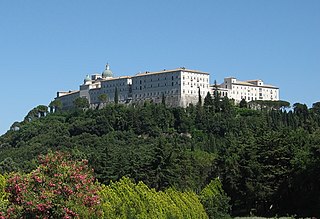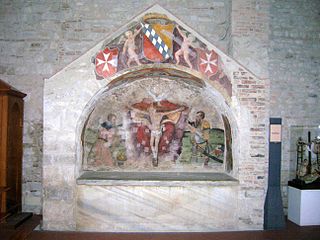Related Research Articles

Robert Guiscard was a Norman adventurer remembered for the conquest of southern Italy and Sicily. Robert was born into the Hauteville family in Normandy, went on to become Count of Apulia and Calabria (1057–1059), and then Duke of Apulia and Calabria and Duke of Sicily (1059–1085), and briefly Prince of Benevento (1078–1081) before returning the title to the Pope.

The Battle of Civitate was fought on 18 June 1053 in southern Italy, between the Normans, led by the Count of Apulia Humphrey of Hauteville, and a Swabian-Italian-Lombard army, organised by Pope Leo IX and led on the battlefield by Gerard, Duke of Lorraine, and Rudolf, Prince of Benevento. The Norman victory over the allied papal army marked the climax of a conflict between the Norman mercenaries who came to southern Italy in the eleventh century, the de Hauteville family, and the local Lombard princes. By 1059 the Normans would create an alliance with the papacy, which included a formal recognition by Pope Nicholas II of the Norman conquest in south Italy, investing Robert Guiscard as Duke of Apulia and Calabria, and Count of Sicily.

Sikelgaita was a Lombard princess, the daughter of Guaimar IV, Prince of Salerno, and second wife of Robert Guiscard, Duke of Apulia. She commanded troops in her own right.

Roger Borsa was the Norman Duke of Apulia and Calabria and effective ruler of southern Italy from 1085 until his death. He was the son of Robert Guiscard, the conqueror of southern Italy and Sicily; Roger was not as adept as his father, and most of his reign was spent in feudal anarchy.
Humphrey of Hauteville, surnamed Abagelard, was the Count of Apulia and Calabria from 1051 to his death.

Bisceglie is a city and municipality on the Adriatic Sea of 55,251 inhabitants in the province of Barletta-Andria-Trani, in the Apulia region, in southern Italy. The city was awarded Blue Flag Beach certification in 2001 for high environmental and quality standards. Scallette and Salsello Beaches were also certified in 2003, 2005 and 2006.

Guaimar IV was Prince of Salerno (1027–1052), Duke of Amalfi (1039–1052), Duke of Gaeta (1040–1041), and Prince of Capua (1038–1047) in Southern Italy over the period from 1027 to 1052. He was an important figure in the final phase of Byzantine authority in the Mezzogiorno and the commencement of Norman power. He was, according to Amatus of Montecassino, "more courageous than his father, more generous and more courteous; indeed he possessed all the qualities a layman should have—except that he took an excessive delight in women."

Amatus of Montecassino, was a Benedictine monk of the Abbey of Montecassino who is best known for his historical chronicles of his era. His History of the Normans, is one of three principle primary sources for the Norman Conquest of southern Italy--the other two being the histories of William of Apulia and Geoffrey Malaterra. Amatus describes the Normans from the perspective of his abbey, one of the most important religious and cultural centers in Italy at the time. His history is the earliest extant account of the Norman sieges of Bari and Salerno, their conquest of Sicily, and the careers of both Robert Guiscard and Richard Drengot, as well as the Gregorian Reforms seen from the papal point of view.
Richard Drengot was the count of Aversa (1049–1078), prince of Capua and duke of Gaeta (1064–1078).

Gisulf II was the last Lombard prince of Salerno (1052–1077).
Herman of Hauteville was the younger son of Humphrey, count of Apulia and Calabria (1051–1057), and his Lombard wife, Gaitelgrima of Salerno, also known as Altrude. His older brother Abelard was supposed to inherit their father's lands, but Robert Guiscard, their uncle, who was elected count on Humphrey's death, confiscated them.

Abelard of Hauteville was the eldest son of Humphrey, count of Apulia and Calabria (1051–1057), and his Lombard wife, Gaitelgrima of Salerno, also known as Altrude. He was supposed to inherit his father's lands, but Robert Guiscard, his uncle and guardian, who was elected count on Humphrey's death, confiscated them.
Peter I, also known as Petronius, was the first Norman count of Trani. He was one of the most prominent of the twelve leaders of the Norman mercenaries serving Guaimar IV of Salerno. Though it had not yet been conquered from the Byzantine Empire, Peter received Trani in the Normans' division of Apulia made at Melfi in 1042. In that same division his brother Walter received Civitate.

The Norman conquest of southern Italy lasted from 999 to 1139, involving many battles and independent conquerors. In 1130, the territories in southern Italy united as the Kingdom of Sicily, which included the island of Sicily, the southern third of the Italian Peninsula, the archipelago of Malta, and parts of North Africa.

Geoffrey, Godfrey, or Goffredo, called Lofredus in Latin, was an Italo-Norman military leader and the first Count of Taranto. He was the second son of Peter I of Trani, though of his elder brother, Amicus, nothing is known. He succeeded his father in the territory of Trani and was in control of it in 1064, though the city itself remained with the Byzantine Empire. His younger brother, Peter II, took the city from the Byzantines in 1054 and, taking advantage of Geoffrey's absence, took control of the patrimony. Geoffrey married a daughter of Drogo, lord of Mottola and Castellaneta.
Ranulf I was the count of Caiazzo in the Principality of Capua from about 1078. He also brought the formerly Lombard counties of Alife, Telese and Sant'Agata dei Goti and the castles of Airola and Tocco Caudio under his control, dominating the region between Capua and Benevento. He passed this territorial lordship on intact to his heirs, and it remained in their possession until the death of his grandson and namesake, Ranulf II, in 1139.
Abulchares was a Byzantine general of Arab origin who served as the catepan of Italy from 1064 until his death. The chief sources for his catapanate are Skylitzes Continuatus and Anonymi Barensis Chronicon. Skylitzes Continuatus records that Abulchares was also duke (doux) of Dyrrhachium across the Adriatic, but this is chronologically impossible, since Perenos is recorded as duke at this time.
Bisantius Guirdeliku was a noble citizen of Bari, then the capital of the Byzantine catepanate of Italy. He held the rank of patrikios. During the siege of Bari (1068–71) by the Normans, he led the faction opposed to surrender until he was assassinated by his rival, Argirizzo, in 1070. His nickname is known from the anonymous Annales Barenses and the chronicle of Lupus Protospatharius.
Joscelin was a Norman count of Molfetta on the Adriatic coast of southern Italy. He rejected the leadership of Duke Robert Guiscard and rebelled, perhaps as early as 1064, certainly by 1067. Defeated, he went over the Byzantines in 1068.

Amicus of Giovinazzo, also Amicus II, was a Norman nobleman and military leader during the Norman conquest of southern Italy. He was the count of Molfetta from 1068 until his death and of Giovinazzo from 1068 until 1073. He came from a prominent family often opposed to the rule of the Hautevilles. In 1067–68, 1072–73 and 1079–80 he took part in rebellions against the Hauteville Duke of Apulia. In 1067 and 1079 he received aid from Byzantium against the duke.
References
- Amatus of Montecassino. The History of the Normans. Prescott N. Dunbar, trans., and Graham A. Loud, ed. Boydell Press, 2004.
- Valerie Eads. "Sichelgaita of Salerno: Amazon or Trophy Wife?" Journal of Medieval Military History, De Re Militari Sessions at the 38th Congress on Medieval Studies, III (2003), 72–87.